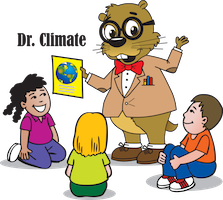Climate Change Lesson 4: Carbon Footprint
Many students may not be aware that even though they are not old enough to drive a car, daily activities still create a carbon footprint. The food we buy at the supermarket, the books and newspapers we read, everything adds to our impact on the Earth.
Why is this so important? The more carbon dioxide produced from everything humans do, the more carbon dioxide the planet's atmosphere has to absorb. When there is more carbon dioxide produced than the atmosphere can handle, the buildup of these greenhouse gases contributes to global warming. Scientists believe daily human activity produces too much carbon dioxide, and it's causing the planet to get warmer.
In this lesson students will learn some facts about their personal carbon footprint and have the opportunity to create a poster meant to educate others about the facts on our carbon footprint.
Activity Level: Medium
Activity Time: 50 minutes
Objectives:
Students will study the impact of daily activity and how it contributes to their carbon footprint by watching a video, discussing some facts about how people create a carbon footprint, and creating posters demonstrating those facts.
Materials:
Poster board, drawing and art supplies
Carbon Footprint fact sheet
Short video
https://www.youtube.com/watch?v=AGRlo87oAUg
Knowledge:
Begin with the short video. Have students take notes on the facts that are presented in the video.
Bonus extra credit: The video is very good, but there are two typos in the text. Award extra credit for each typo the students find while watching the video.
Once the video is finished, have the class share the facts they wrote while watching the video. Ask if they might have heard of other facts about the carbon footprint, such as how cars contribute to it, or how many plastic bottles throw away. Share more facts with the students with the Carbon Footprint Fact Sheet.
Activity Intro:
Pass out the Carbon Footprint Fact Sheet to share with the class or put on the overhead/smartboard.
Carbon Footprint Fact Sheet
Did you know in your lifetime:
- 12,000 oranges will travel 23 million miles so you can eat them.
- You will burn 31,000 gallons of gasoline.
- You will use 43 trees to read 5,000 newspapers.
- You will produce 64 tons of garbage.
- You will use 1.8 million gallons of water.
- Americans throw away 60 million bottles every day.
Teacher: "With partners we are going to use these facts to design posters."
Lesson Overview
Assign partners for this project. Students could also work individually if that is preferred.
Pass out poster board and art supplies. Students can work in pairs or on their own. Have students pick one or two facts from the video or the fact sheet and have them design a poster that illustrates that fact.
When the students are finished with their posters, have each pair or student share their poster with the class, explaining their fact, why they chose it and what they designed on their poster to illustrate their fact.
Conclusion:
Display the posters around the school to share with other students. Different classes could also hold a contest with prizes for the posters that do the best job illustrating facts about our carbon footprint.
Extension Activity
Have students research different topics related to the human footprint and create a report on ways people create problems for wildlife to survive and how human behavior can change to protect wildlife. Some examples of report topics could be:
The Great Plastic Garbage Patch
Protecting Wildlife
Human Population Growth
Problems with using Plastic